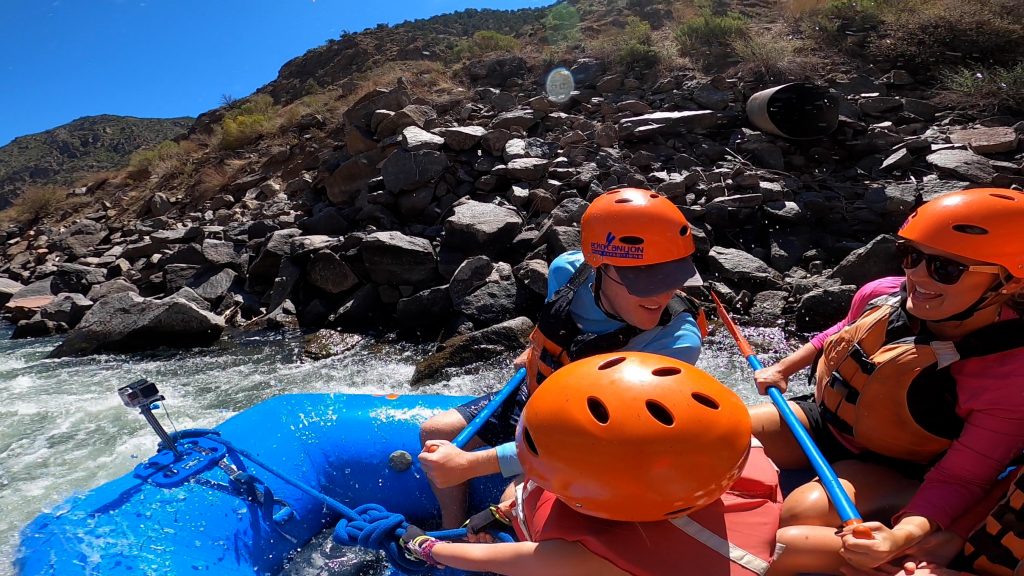It felt like the Lewis and Clark expedition. We put our canoes in Flagstaff Lake and began to paddle north around the Bigelow Mountain range. It was late morning and the lake was still calm. A light breeze was drifting in from the southwest, and our expedition of four canoes laden down with dry bags, coolers and adventurers drifted along with it. The sun was strong and warm. We paddled without shirts to stay cool, but with a solid layer of sunscreen to stay smart.
Straight off, one canoe team attempted to make a sail with paddles and a poncho to minimize effort on this leg of the trip. They were rocking the boat, shouting to the other canoes for pieces of string or whatever else they could use to rig their sail. It was entertaining to a point. But the three other canoes paddled on and ended up waiting for the sailors to abandon the project and return to the old fashioned paddle system to catch up.
Flagstaff Lake is the result of an old river being dammed up and flooding the valley. The water level continues to vary as we learned the hard way when we attempted to paddle around an island close to shore and found marshland bridging the two. It wasn’t quite a portage, as the canoes would be high enough out of the water if we got out ourselves, stepped into the grassy muck of a bottom and pushed them along. I’m sure Lewis and Clark had similar experiences, but on a much grander scale. Unlike Lewis and Clark, however, we had a map, which told us it would go through! It is all part of the adventure of discovery and learning that maps need to be taken with a grain of salt.
With our attention so focused on getting through the swamp, we failed to see the large thundercloud heading our way. Not long after our pseudo-portage we heard the faint rumble of thunder from the southwest. That cloud was heading right for us. We had to get to shore. After a quick look around, all the shoreline near us was swamp and marsh. The next piece of solid land was still five minutes away. With a shout to the crew and a powerful stint of paddling, we made high speed to the shore and pulled our canoes out of the water before the thundercloud passed over us. We never really saw any lightning, or really heard any thunder right over us, but it was the safe thing to do. While we waited for the thundercloud to pass over, we got out lunch and made a good dent in our PB&J pitas, dried fruit, and GORP rations.
Our next stint on the water was very windy. The crescent shape of the lake (following the old river) curved us around to a more easterly course, and the wind, still blowing from the southwest, made it difficult to go straight as it kept trying to blow our bow further northward.
Suddenly, like a brick wall, the wind stepped up and we were surfing 2-3 foot breaking whitecaps. We immediately headed towards shore and didn’t even need to paddle, as our backs were enough of a sail to propel us through the water. All that was needed to steer was a paddle in the water to act as a rudder.
We landed on a sandy, yet driftwood covered beach. After pulling the canoes up on shore, we crept into the brush beyond the beach and hunkered down in our rain gear and waited the ten-minute storm out.
We were soon back on the water. Though we still had a stiff breeze to our backs, we paddled safely on and wove through a series of islands, which put us in a nice calm wind shadow for a while. We eventually rounded a massive point of land before finally reaching our destination for the night, Hurricane Island.
No more than an acre or two in size, this small lot of land was a very fun place to take over and call our own for the night. Each of the three tents could claim its own lot of land and it was like our own little colony had formed. Once the tents were up, there was more to explore. The northern corner of the island is thickly wooded and quite mysterious. On the eastern shore were we beached, it’s sandy and pleasantly protected from the winds that persisted from the west. The west side, however, did have its appeal. As the sun set a few of us chose to walk across the island after dinner and gather there to tuck the sun in for the night.
The next morning it was a leisurely start as we only had just over two miles to paddle to reach our destination for the day. The wind had died down overnight, but a firm breeze was with us once again and we covered our route in no time flat.
The rest of the afternoon was a lazy lounge and we finally got camp set up on a beautiful point of land where the morning sun made a spectacular entrance to start the day. We abandoned our canoes on the last day and took to the hills. A five-mile round trip finished our adventure nicely as it put us at a great vista point overlooking the hills beyond the Bigelow range.



